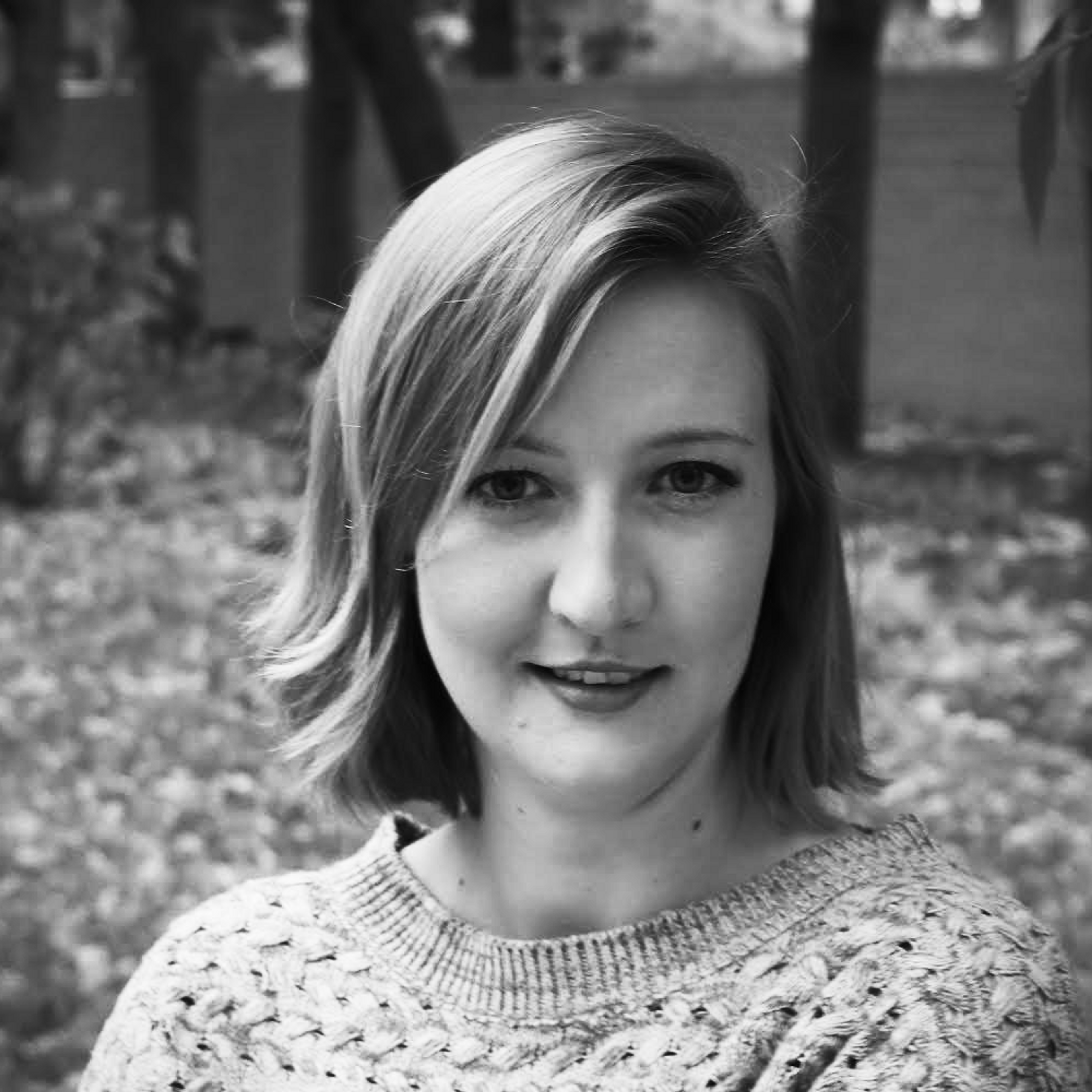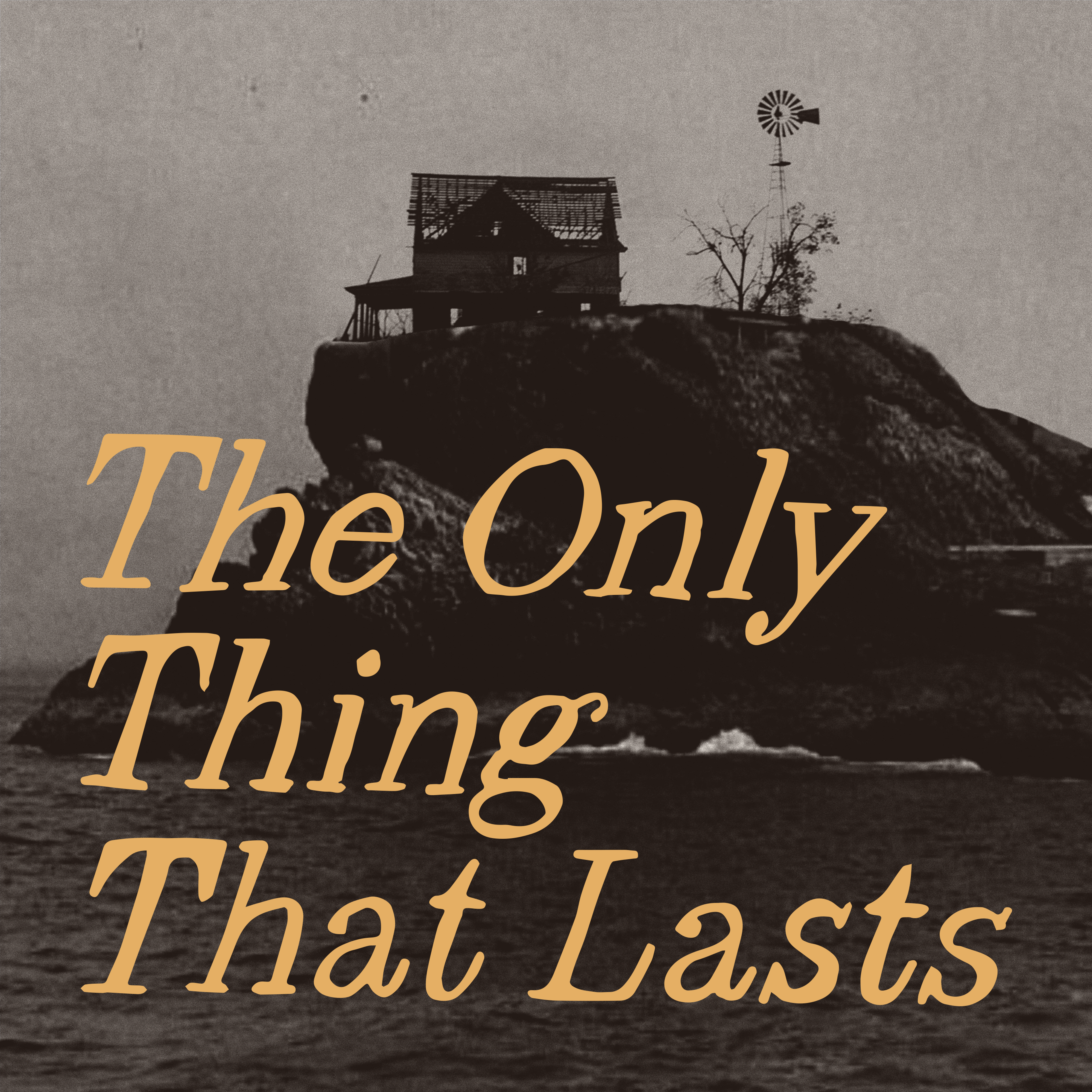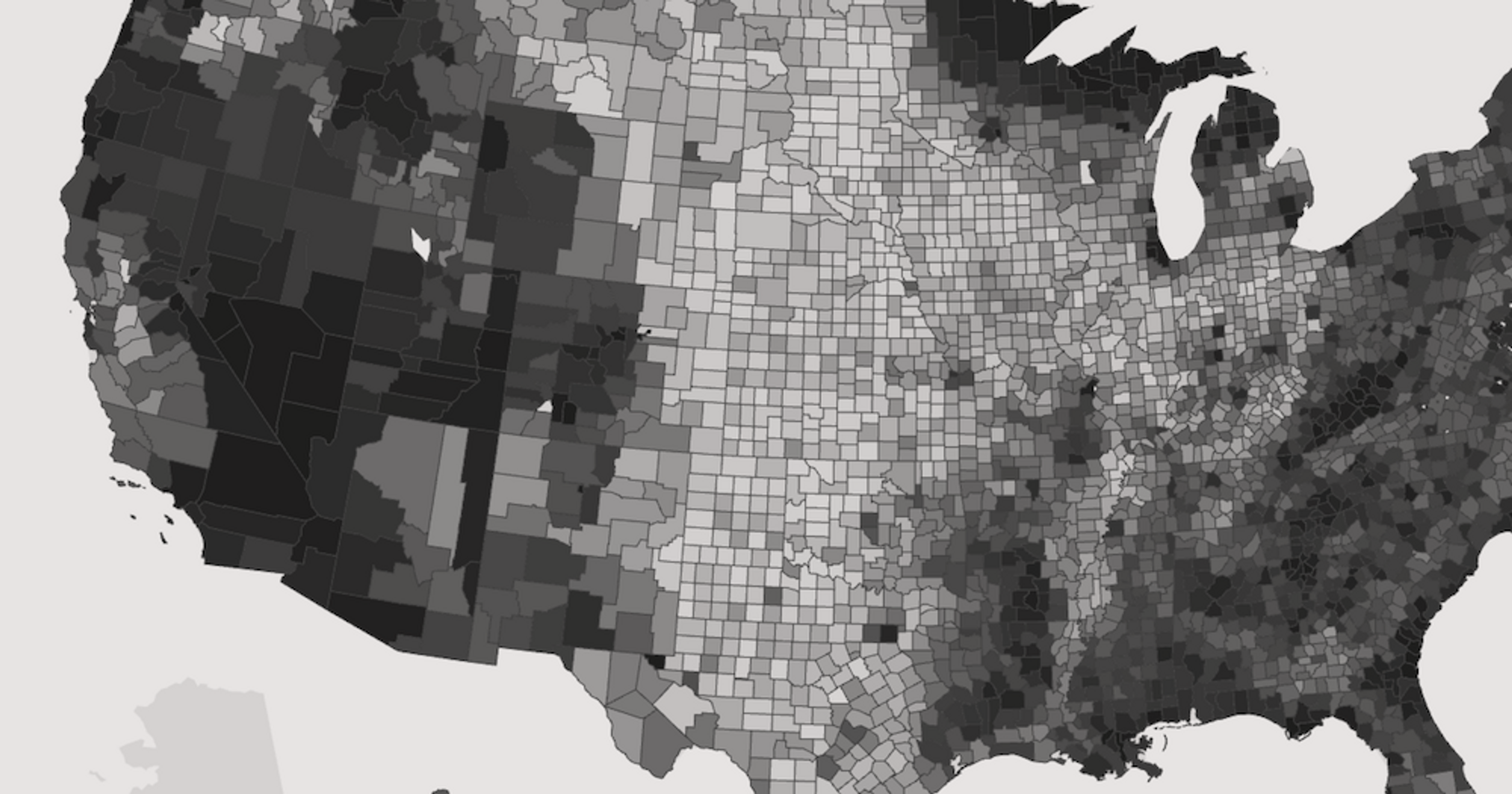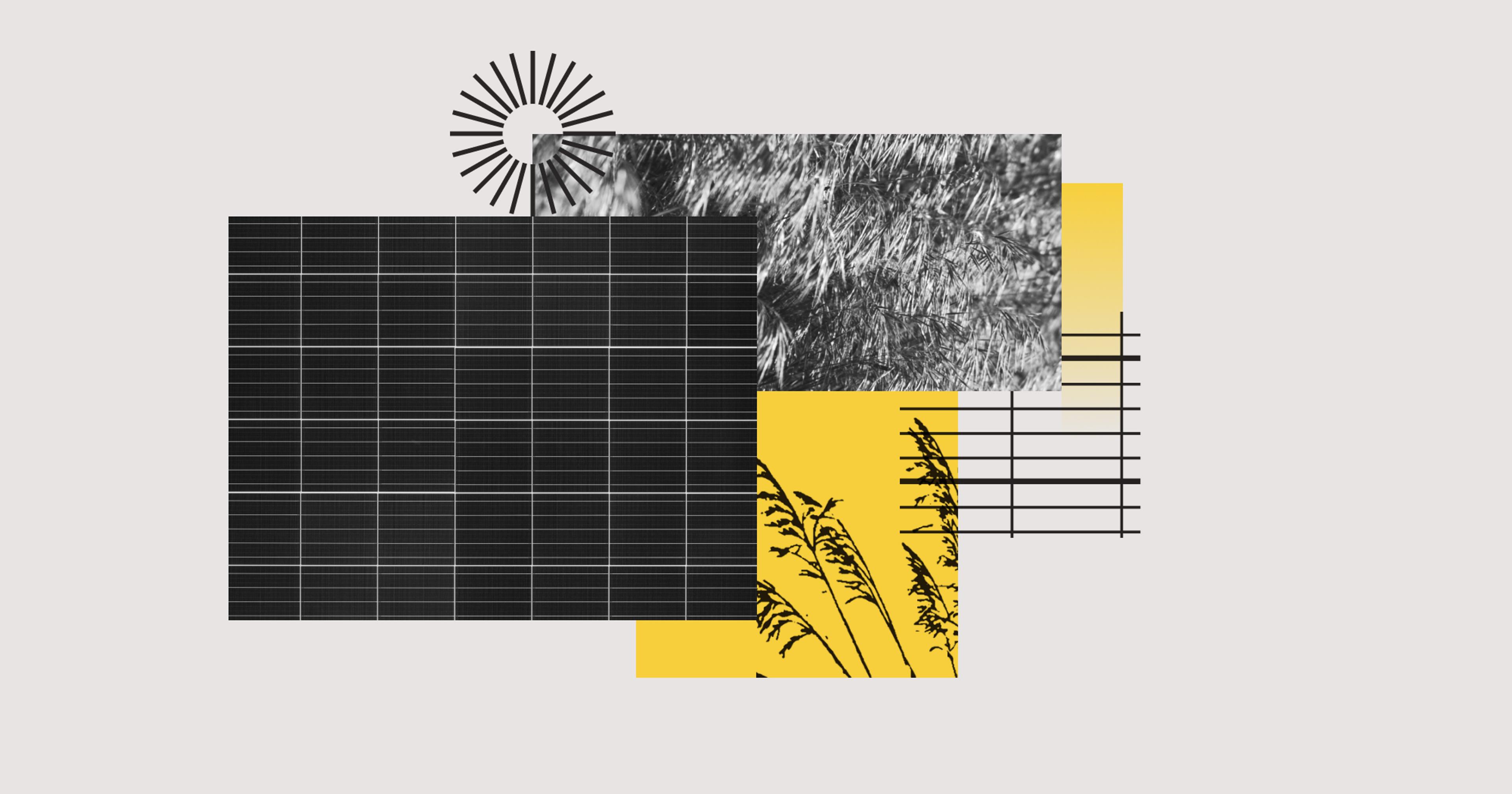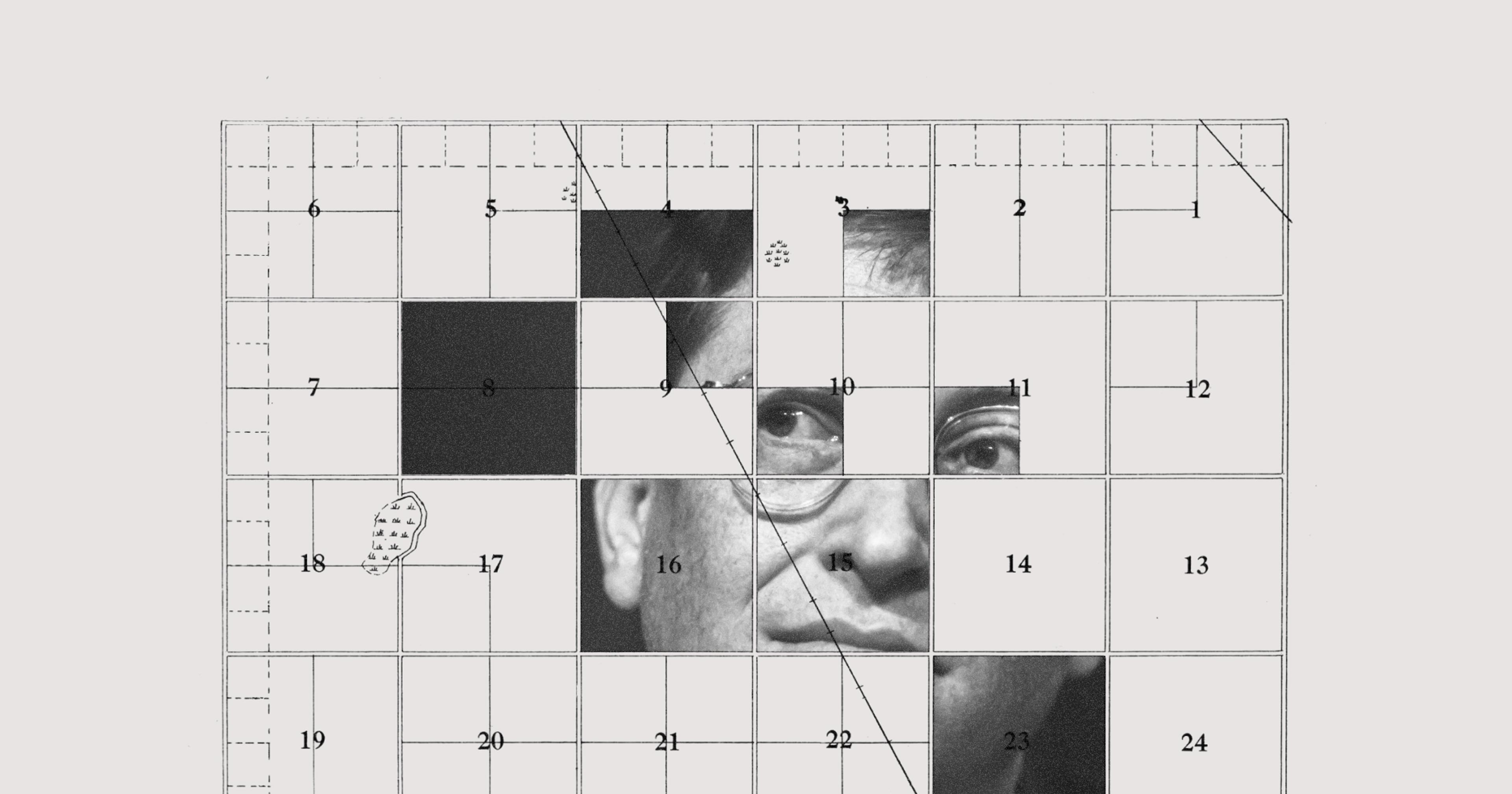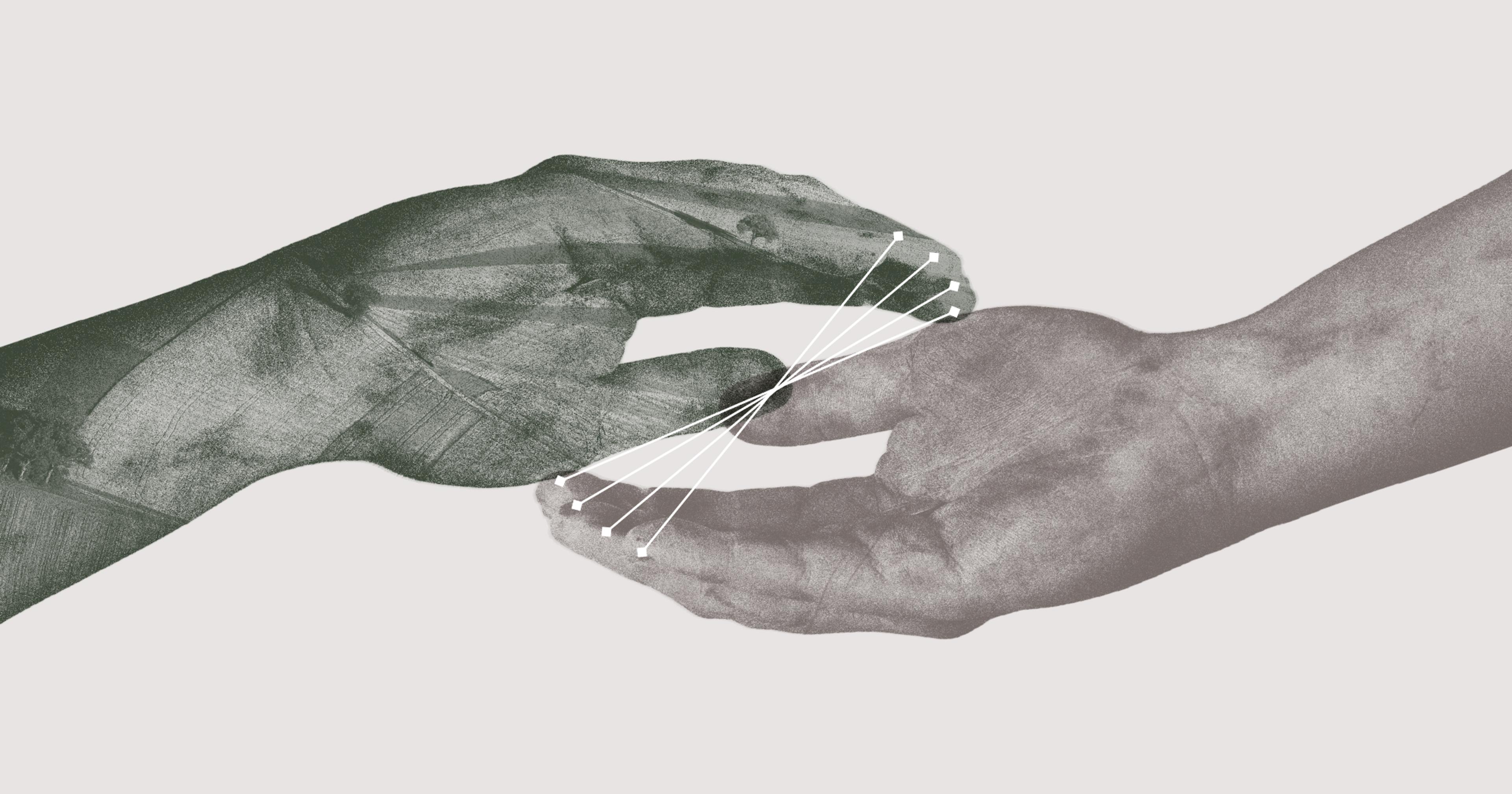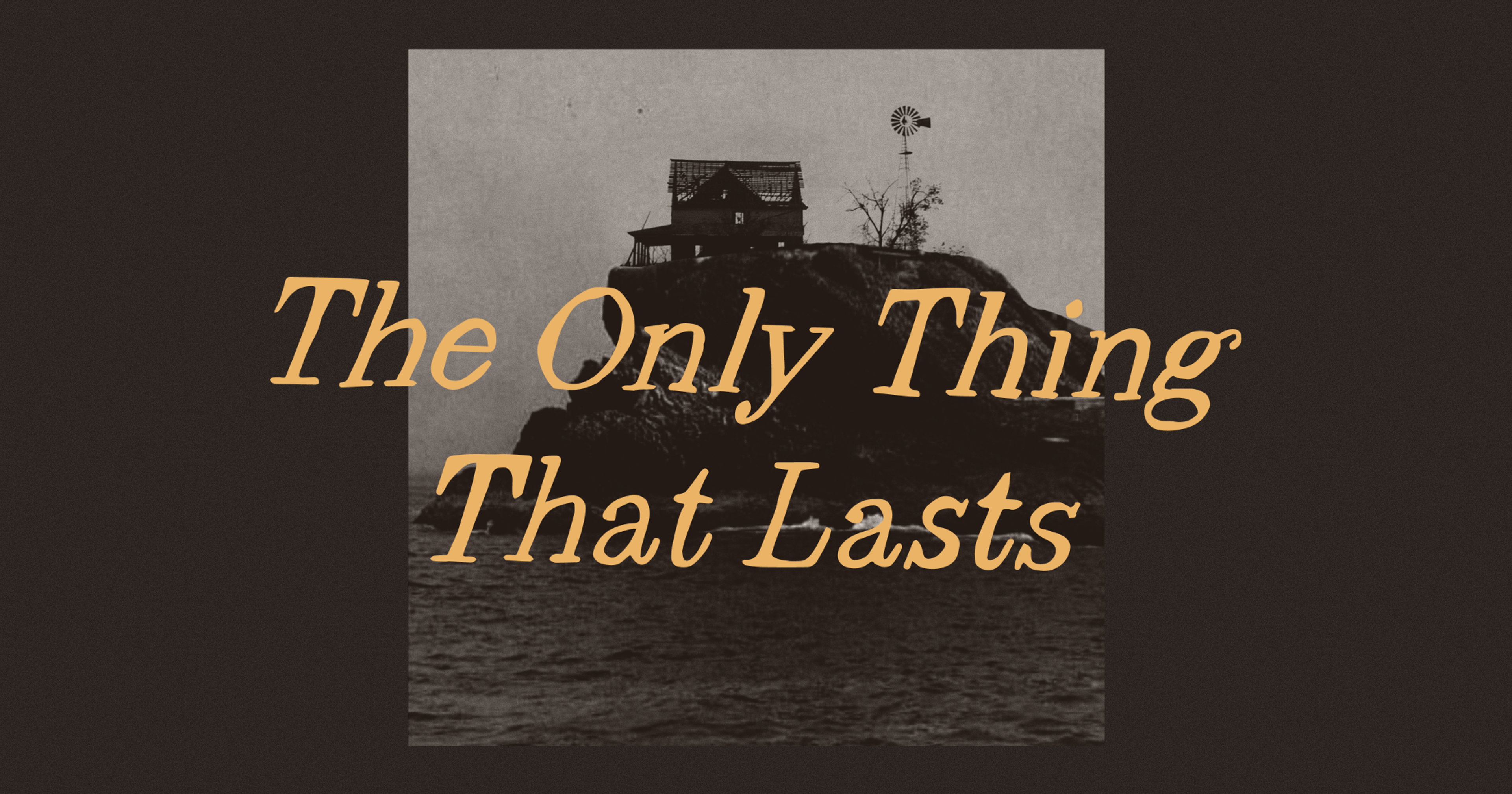Farmland didn’t always exist — it was created.
Subscribe on your favorite podcast app: Spotify, Apple Podcasts, Overcast, Pocket Casts, Amazon, or via our RSS feed: (https://feeds.megaphone.fm/onlythingthatlasts).
INTRODUCTION: Making Farmland, Making Private Property
[NATURAL SOUNDS — Spirit Farm]
Sarah Mock: I visited a farmer recently, a few dozen miles outside of Gallup, New Mexico. The farmer, James Skeet, toured me and a couple of other visitors around his farm, and we sloshed through the February snow-mud to learn about his animals.
[NATURAL SOUNDS]
James Skeet: These are my main breeders. That’s Junior … Junior! So Dewayne is making like a hogan, you know an octagon?
SM: There’s plenty of pigs, Junior included. There’s chickens, ducks, and turkeys, a few cattle. And then there’s the sheep, including some of the rarest, and most threatened sheep in the world: the Navajo Churro.
JS: The Churro still has a wildness in them, from the Spaniards [who] brought ‘em in and the Navajos loved them because they could easily take ‘em right into the blankets. And this one right here is an ancient line that comes from, they think it was bred with a bighorn. [Other voice: “It’s possible.”] Yeah, so there was a whole religion, only the medicine people would eat. Eat the meat of that. So there’s some ancient stuff. And when the Navajos were rounded up to go to Bosque Redondo, they led them in the canyons, and when they came back, they were still there. {Voice: “Wow.”] So there’s an affinity, a relationship there.
SM: The relationship that James is talking about here isn’t just between the Navajo Churro and the Navajo. He’s talking about a relationship between the sheep and the land.
See, Navajo Churros were able to survive on the land without much human intervention. European livestock in North America, on the other hand, required a high degree of care. Which was fine with colonists. Herding sheep, like planting wheat, milking cows, and feeding chickens, was a key part of the agrarian culture they brought with them.
And it was from practicing this culture that Europeans extracted something world-changing from the land: private property. Private property is not really a thing we think of as having a history, per se. It often feels almost like a fact of nature, like it has always existed. But private property, like and alongside American farmland, was actually made. The story of how private property came to be in the U.S. starts with farmland.
Because land to farm was the original possession wrenched from quote unquote wilderness on America’s shores. That’s the story we’ll explore today, here on The Only Thing That Lasts.
[Interlude]
PART 1 : Original Farmers w/James Skeet
SM: After the tour, James and I ducked inside the hogan, the octagonal building at the center of his farm that serves, among other roles, as a community meeting place. This afternoon though, it’s empty but for us, as he tells me a bit more of his story.
JS: My name is James Skeet, and I’m on the Jah Klash Sheh clan, which is on my mom’s side. It’s the Red Cheek clan. Ki ya ah nee ay bah shish cheen. I’m born from my father, which is the Leaning Tower negotiators. My mom’s clan is, they’re lawyers, they’re fighters, they raise hell, they speak the truth. And then the Ki ya ah nee, it is the bridge builder, the diplomat, working with the system. I’m out of a place called Vanderwagen, close to Cousins Road. We have a farm there called Spirit Farm.
SM: James’ homecoming to this farm, and the land it occupies on the Navajo Nation in Western New Mexico, wasn’t a simple taking up of his inheritance. The farm, unlike the Navajo Churro, had not thrived in the absence of caretakers. And so after his parents had passed on, James returned to a land in crisis.
JS: The land was speaking to us and saying that, I need help. Because of the plowing and the conventional farming that my grandfather had done. The land was in dire straits. You could almost feel it. The voidness of living things. It was very desertified. There was a junkyard here There was a lot of thistle, what we call hyphe. It was hot. It flooded. And when we came, I had this covenant that I’d made with the land, as I was singing on the land, as I was praying, as I was drumming on the land, that the land was saying to me: When you leave this earth, make sure this land is in better shape than when you came in. Which seemed very difficult and impossible to do.
SM: James’ challenge, to shape and reshape the landscape to make it healthier, more habitable, and abundant, was an intensely personal challenge for him, but it is also one of humankind’s oldest traditions. His aim was not simply to farm a crop, but to grow farmland where there was now a void.
For him, the first step was to focus on what was possible for the land itself. He and his wife looked to the soil on which everything lived, and began to understand its capabilities. Then they set to work, not to wage war against thorns or floods or heat, but to repair what previous farmers had destroyed.
JS: Working with the microbiome in the soil, working with our own health, with our own healing, understanding that there is, things that we can do to remediate the dirt into soil, using compost, using techniques that could help speed up this almost 60- 70-year detriment to the soil that my grandfather had done. We started seeing things like plants that we didn’t see come out in the springtime. We saw that the flooding was less and less. We saw that there were animals and birds that did not show themselves since I was a kid, start showing up, and we started seeing an oasis.
SM: This transformation took years of work by James, his wife, and a litany of human, plant, and microbiological helpers. And it was several seasons before they were even able to plant beans, potatoes, and green chilis, our regional staple crops. In the meantime, as the soil was slowly undergoing its transition, the Skeets were exploring livestock — starting with the Navajo-Churros.
Today the Skeets are continuing a long Indigenous tradition of transforming landscapes into farmland in the Americas. Literally making farmland. And it’s really hard to overstate how long this tradition is. In fact, if you want to talk about the first North American landscapes transformed for farming, you better be ready for a very long ride in a time machine.
PART 2: Agricultural Geography
William E. Doolittle: There are a bewildering variety of agricultural landscapes in North America prior to 1492.
SM: That’s William E. Doolittle, a recently retired professor at the University of Texas at Austin, where he was a professor in the Department of Geography and the Environment.
WED: The indigenous people of the Eastern woodlands, from the Atlantic coast into the Appalachians. These people were farming land and they were clearing the forests, and planting maize and beans and squash, all in the same fields together. And that was a practice throughout most of North America.Not only in the Eastern woodlands, but also in the riverine areas down the Ohio River, along the floodplains of the Mississippi River near St. Louis, Missourim and up the Missouri. There were agricultural people farming those riparian areas, that in their natural state would have been rather heavily wooded.
SM: William has spent half a century studying these kinds of historic and prehistoric agricultural landscapes in North America, with a special focus on the farmland modifications made by Indigenous peoples. And what it took to turn natural environments into cultivated ones.
WED: If there is one thing that sort of underlies a great deal of my thinking on agriculture and agricultural land, it is that agricultural land does not exist until it’s made. We often look at farmland, land under cultivation today, and go, wow, this is great farmland, forgetting the fact that at one time it wasn’t farmland, and it only became farmland when people made it farmland.
SM: And it was the Indigenous inhabitants of the continent, members of the more than 1,000 distinct civilizations that existed before 1492, and whose descendants, like James Skeet, are still here, who made much of this nation’s farmland. Whether the task was the more simple project of clearing trees or leveling land, or the radical changes involved in building terraces or irrigation canals, what’s clear to William from the geographic evidence across North America is that humans have been farming here for a long time. And like humans the world over, they’re always looking to make farming easier and more efficient. Some of these Indigenous alterations were so advanced, in fact, that we’re only just now beginning to understand how they work.
WED: Up in Wisconsin, and in Michigan, farmers built a series of, God, there’s hundreds of these in those states, some of them still existing. A series of ridged fields, where they literally excavated ditches and piled the dirt up into a series of ridges. And for a long time, nobody knew exactly what they were used for or how they were used. But then some archaeologists did some experiments and discovered that by elevating these planting surfaces, a foot to 18 inches, facilitated cold air drainage. You know, hot air rises, cold air drops. By planting on top of these ridges, they could extend the growing season about 60 days.
SM: But not all North American peoples were felling forests and building great earthworks.
Many others found that the easiest and most efficient way to procure what they needed from the landscape was with strategies that, in many ways, challenge our ideas of what agriculture even is.
WED: The Owens Valley Paiutes for a long time have been excavating irrigation canals to irrigate stands of wild grasses. So here you have wild grass, but people are irrigating it. So is that agriculture? The Ojibwe in northern Minnesota and Wisconsin had a method of going through dense stands of wild rice in their lakes. And collecting the grain by raking it over the sides of the canoe and connecting it in the canoe. It’s wild grass, wild rice, okay? But they got so good at it that they wound up after harvest, going back through the lakes, throwing some of the rice back in for next year’s crop, okay? So you might say, they were gathering rice. But by virtue of throwing some back, they’re planting rice.
SM: William makes the case that there is tremendous gray area between “agriculture” and wild harvesting or gathering. He’d argue that if I found a stand of wild blueberries in the woods, and broke off a branch of an overhanging tree so that it gets more light, I’m now farming these blueberries. I’ve committed a cultivating act, by altering the landscape to encourage the land to produce more.
For William then, it’s clear that for hundreds if not thousands of years, much of North America was being actively farmed, for food, fiber, fuel, and other supplies. William actually worked with Charles Mann — author of 1491, a watershed text on Indigenous peoples in the Americas — to map thousands of sites all over the continent, where evidence of farming and farmland pre-date European contact.
And yet, despite what we’ve learned about Indigenous efforts to turn land into farmland all over the country, private property, at least in the modern sense, didn’t arrive on the North American landscape until Europeans did. So what secret did these invaders know, about turning the alchemy of turning farmland into *your* farmland?
That’s after the break.
[Ambrook ad]
Now, back to the show.
PART 3: How Europeans “Improved” Their Way to Property
SM: So Indigenous peoples of North America, in the past and even today, had plenty of farms and farmland. In fact, Europeans who first made contact with Indigenous populations in the Americas were constantly recording and reporting back what they’d witnessed and learned about Indigenous agriculture. And it was … a lot.
We can be pretty confident that Europeans understood what they were seeing, because Western thinkers have been philosophizing on the nature of private property since Plato and Aristotle debated the virtues of collective vs. individual ownership. But it was in the 15, 16, and 17 hundreds that Europeans started to really wade into clarifying how they believed property worked. At least, theoretically.
[Classical music overlay]
John Locke was perhaps the preeminent property theorist of his day and a thinker whose arguments still hold sway in academic and legal spaces today. The core of his argument around ownership went something like this: The fundamental property of all people is their own person, specifically their labor. Then there’s the Earth and everything on it which — and I’m paraphrasing Genesis here — God gave so that people would have dominion over it. And so when a person adds their labor to the unclaimed, undominated world, then the thing that they’ve labored on — or to use Locke’s term, “improved” — is now their private property.
John Locke’s theories, and others like his, were key to motivating and justifying European, especially British, colonial actions all over the world. And deep down, they’re at the core of how we explain owning property even today.
And Europeans were hungry for justification. Because in the first century after contact with the Americas, plenty of Europeans came down on the side of Indigenous property rights. Case in point, in 1532 a theologian in Spain declared that, “Indians were true owners … of the lands they occupied.” Shortly thereafter, Pope Paul III officially agreed, saying that “Indians are by no means to be deprived of the possession of their property.”
For many colonists hungry for resources like wood, tobacco, cotton, or at least the profit to be made from selling these commodities, the idea that all the “unimproved” land in the Americas was not free for the taking, was unacceptable.
But philosophies like Locke’s, alongside religious and pseudo-scientific racial theories, gave European colonists legal and intellectual cover to take Indigenous land for themselves. See, Locke argued that Native Americans were not rightful owners of their continent because they were only “hunters and nomadic people,” and thus not true improvers of land.
Virginia DeJohn Anderson: Well it’s interesting because of course the English come over and say, oh, there are no people here.
SM: That’s Virginia DeJohn Anderson, a retired professor of Early American History at the University of Colorado, Boulder.
VDA: The phrase they would often use is the Indians roamed over the land like deer. Even as these English see Indian cornfields. So depending on the reason for what record they’re keeping, they’re either acknowledging Indian agriculture or not.
SM: I wanted to talk with Virginia about how Europeans — specifically Brits in New England — started to transform ideas into deeds. To the ground, that is. And in the beginning, it was the king of England, not philosophers, who mattered most.
VDA: When the first English settlers come over, they’re assuming everything they see is English land on the basis of John Cabot’s 1497 voyage. And they, in Massachusetts, let’s say, they have a right to this land because the king gave them that right through the Massachusetts Bay Company, which becomes the Massachusetts General Court, the legislature.
SM: These agents could then distribute this land to settlers, and often all it took was the coming together of a group of men who promised to settle and be industrious — make improvements, in other words. With that commitment, the court would grant them a tract of land to divide amongst themselves, totally free of charge.
This was utterly revolutionary — many of these colonial settlers would have never, in their wildest dreams, had the opportunity of ever owning land in Europe. Though some of these settlers would have been farmers in England, they were almost certainly tenants, rentiers, as their families had probably been for generations. In fact, even the word “to farm” originally meant something more like “to rent out.” As in, when a lord, a great landholder, would bring in farmers, or people who pay for the right to use the land. In Europe farmers were, by definition, tenants.
Indigenous groups in the area, of course, did not have this same historical baggage around land tenure.
VDA: Again, the native people saw land as a resource that was something they used, not owned in the same way. There were native groups like the Wampanoags up where, who met up with the pilgrims in the Cape Cod area. They would have territorial claims to a section within which they would be Native villages. But an individual Native person never owned a piece of land in the way an individual English settler did.
SM: Given that there were thousands of distinct Indigenous groups, each with unique rules and taboos around everything from land inheritance to control, and that colonists destroyed holders, histories, and records of this knowledge, it’s really difficult to generalize about Indigenous property ideas. But there are a few things that historians are pretty confident about. One of them is that, for Indigenous people, ownership over a territory or region was often collective, not individual.
Yet individuals and families could often control all the land they were able to farm within the territory. But, if the individual stopped tending their land, it would then revert to community control, to be redistributed or turned to other uses. This tenure system — what’s called a “use claim” system — was not unknown to Europeans. In fact, systems like this share many similarities with both the “common” system — which were once extremely common in Europe — and corporate ownership.
But there was one particular outcome of the use claim system that many Europeans found unappealing. Namely, it prevents massive accumulation of land by individuals, and therefore the intergenerational building of land-based fortunes.
But the fact that Europeans had established ideas about private property and that Indigenous peoples relied on ideas of collective and use-based land tenure, was not the major focus of conflict between these two groups at first. The problems started, on the settler side, with their strategy for colonization.
VDA: Well, they came thinking they could simply replicate what they had been doing in England. There’s a lot of discussion in some of the early materials that, oh, this is just like England, the climate. The landscape needs development because there are these woods and unplowed lands. But, we can figure this out for ourselves. We can turn this into something that we can use. And so they brought agricultural tools, and they brought livestock — cows, pigs, horses, sheep — and just assumed they would have their farms growing food.
SM: These Englishmen, however, were in for a rude awakening. Wheat, the touchstone of the English diet, doesn’t grow very well in New and not-so-England. And the livestock they’d brought with them were also not growing like they always did on the English Commons.
VDA: It takes them a while to realize the natural grasses in New England will keep a cow alive, but not necessarily sort of fatten it up because they’re less nutritious for livestock than the grasses grown in England. And because it’s less nutritious, you need a lot more land with those grasses growing on it to feed your livestock.
SM: The amount of land needed for animals to graze was far too much to fence, so the colonists went with a completely different strategy.
VDA: So what they do, ultimately, is fence in their croplands, to keep the marauding animals out and then let the animals run free. They have to bring them back in New England in the winter ,because otherwise they’d freeze to death. But nine months out of the year, ten months out of the year, livestock are roaming free. And that’s not what they had intended to do. And that’s the source, of course, of a lot of the conflict with Indians.
SM: These conflicts ran the gamut, but one specific issue was particularly common.
VDA: Livestock created problems that showed up in the public records. Principally trespassing.
SM: That’s right, trespassing. See, unfenced cattle and pigs tend to go places they’re not supposed to go, and when they’re there, they can destroy a lot of stuff. Especially the tasty and nutritious crops grown by nearby Indigenous people.
But that wasn’t actually the biggest part of the problem. The larger issue was that, when Native people dealt with these cattle and other livestock in their fields, as they had always dealt with pests — by killing them — angry colonists would often come after them.
VDA: This crucial English idea of a domestic animal, which is that this creature is property that is yours, and nobody can take it away from you. And if an Indian shoots a cow in his field, he has taken away the property, he has stolen the property of an English settler. Native peoples did not have this same sense of, certainly not property in living animals. So we find in the records Native peoples being prosecuted for shooting a cow, and you have to kind of imagine what it was like for that, especially that first Native person dragged into an English court, by the way, they use their legal system to prosecute as they would prosecute an English settler.
SM: In this way, cattle and pigs became the tip of the spear of colonialism, and of private property. These animals, which were seemingly neutral beings wandering the landscape, were in fact living property. It’s right there in the name — live stock — as in living product, live possession.
These animals were physical embodiments of European ideas of ownership that, as they trod the land, transformed it. By physically changing the environment, by destroying crops and triggering conflicts that led to the impoverishment of Native communities, and essentially expanding their owners‘ claim of property wherever they went.
John Locke’s theory argues that property is created when people exert their labor on the land, when they improve it — a word which originally meant “profit from.” And livestock became a potent agent of that work, extending European property claims wherever they wandered. And critically, livestock often did not have to wander very far.
VDA: One of the things is that the Indians were omnipresent. I don’t think you lived in a New England town throughout the 17th century without encountering Native peoples all the time. They weren’t separate. Trespass wouldn’t have been a problem if these villages were 15 miles apart. These are not separate people. The Native people certainly have not died out. They’re adapting.
SM: Part of the problem is that even as migration from England slowed, the population of Europeans in New England exploded because they had huge families. And in order to feed those families, livestock populations were also exploding.
VDA: It compels the English to push against Native peoples and keep pushing them out. So the Native peoples never disappear from the settlement areas, but their role is diminished over time as they’re forced to relocate.
SM: As decades passed, Europeans seemingly got more and more turned around by their own mental gymnastics. For example, a movement was afoot from early days to encourage Native populations to adopt domestic livestock husbandry, since the English believed raising cattle was one of the ultimate civilizing forces. But evidence shows that when Native peoples did start raising livestock, specifically pigs, and selling them in English markets at competitive prices, colonists got mad, and did their best to shut them out of the marketplace.
But this isn’t, by far, the worst of it. Indigenous groups that encountered the English in New England may not have been raising livestock in the 15 and 1600s. But James’ people, the Dine‘ of the Southwest, certainly were. And yet, neither the Spanish nor other European colonists
respected their ownership rights to their own ancestral land, despite the fact that these people were doing the exact same things that had earned these rights for European settlers.
In the end, the English determined that their own agricultural practices were property-worthy, while the landscape transforming and community nourishing farming practiced by their Indigenous neighbors was not. The main difference? English products were profitable in European markets.
[Interlude]
SM: So this was the milieu in which our modern concepts of property began to solidify.
It would be more than a century later that the early crafters of American law would start to establish their vision for a country not united by “love of God and King” but by love of “life, liberty, and property.” Except strike the property part, Thomas Jefferson. It sounds much more noble to say “pursuit of happiness,” doesn’t it? Though arguably, for Europeans at the time, the difference between property and happiness was marginal at best. Because especially for poor Europeans, many of whose families had likely been poor for centuries, this was the first time in history, they’d had an opportunity to fundamentally alter the trajectory of their lives, and the lives of their descendants.
Of course they first had to abandon their ancestral place, cross an ocean, appeal to the king or his agents for permission to settle, and then usually go through the process of proving up a claim. Providing evidence that they had indeed exerted their labor on the land in a way that had transformed it into their private property. This could be by clearing trees, plowing fields, building fences. And once this was done, they might have to pay a somewhat token purchase price. Then the land was theirs. And with it, a duty to king and country to pay taxes.
But what does it actually mean for land to become a persons’ private property? Well for one, private property comes with rights. Under the U.S. legal system, this is a whole package of rights. The right of possession — to say something is yours and for it to be yours. The right of control — to use it as you see fit. The right of exclusion — to prevent others from using it. The right of enjoyment, and the right of dispossession. To sell it, to destroy it, to transform it, whatever you want. This package of rights is enshrined in common law and in state laws, and perhaps most powerfully protected by the 5th Amendment of the Constitution. That’s right, pleading the Fifth isn’t just about avoiding self-incrimination. Your Fifth Amendment right also prevents private property from being taken for public use without just compensation, through what’s known as the Takings Clause. The Takings Clause itself can be traced to origins in the Magna Carta, but property rights in the American colonies and the early United States proved particularly potent even compared to those in Europe.
Why? I think this is a question with many answers. But to me it seems that Americans developed some of the most aggressive property right laws of its age frankly because, they had to. The founders of the U.S. built an agrarian nation, one specifically tied to the land, on that was only theirs by virtue of claims by European kings. And on land which was already occupied by Indigenous peoples. This was an incredibly delicate needle to thread, and it required the establishment of unquestionable property rights that throughout U.S. history have time and time again required protecting through violence and bloodshed.
Simon Winchester, in his book Land, argues that the most essential American property right boils down to this: having the right to call the police and have anyone you want forcibly removed from what’s yours. Our story today bore out this argument.
We saw colonists use the right to have people punished for violating property to push Indigenous people of their own lands when they killed livestock. Then once the land was emptied, defined, titled, and owned, exclusion was used to great effect. It took powerful laws to deprive the Native people of North America of what many Europeans agreed was rightfully theirs. And today those same laws continue to protect real property, or real estate.
But alongside our modern concept of private property, which is rooted in this history and since then has expanded in pretty much every direction, other ideas about land tenure, and the human relationship with the landscape, persist in the minds and hearts of people like James Skeet of Spirit Farm.
JS: And we began to almost write a new story about who we were on the land. Before that, we were just existing on the land. But now we are coexisting with the natural cycles on the land itself. And the land has become us. And we become the land. We no longer own it. The land owns us.
SM: I’ve spent a lot of time working with James, but I still haven’t gotten use to the casualness with which he is able to upend conventional, and I should say, white or Euro-American wisdom about property.
For the Skeets, however, their labor has not entitled them to private property. Their land, like reservation land across the country, is owned by the Bureau of Indian Affairs, which today still holds 56 million acres of Indigenous land “in trust.” The Secretary of the Interior, the federal department under which the Bureau of Indian Affairs sits, has to approve most actions on this land, whether it’s to be sold, developed, or otherwise altered. And perhaps expectedly, this permission is often very hard to get. Plus when reservation land is interspersed with private land in a “checkerboard” pattern, as the Skeets‘ property is, it’s often even more difficult — next to impossible, for the people on the land to make decisions about how it’s used, or how it might be altered.
But this fact hasn’t prevented James and Joyce from doing what they can, to keep the covenant they’ve made with the land. The land that, despite the legal boundaries that would keep him at a distance, James does not see as separate, or separable, from himself.
JS: I try to go back and say, what does it mean to be a part of this land? What does it mean to have my origins? Or in other words, as Navajos would say, what does it mean to have your umbilical cord buried on the land?
SM: Today, our conversation has centered on the idea of private property. How land, through the alchemy of profit-making, becomes personal possession. But here, James offers up a different kind of magic that transforms land. Not into something owned, but into something sacred — the vault not only of our ancestors, but of a part of ourselves. This idea resonates with me deeply, as a person who’s moved around too much, who’s craved the ability to settle, to put down roots, to feel at home with all the safe, secure, nested feelings that come with finding a place to stay.
And we did it, we bought a house. Or technically, the bank bought it, and we’re in the process of buying it from them. But, according to the state and the IRS, we have acquired property. It was a long, hard road, involving sacrifice, stress, and a lot of luck. I’m proud to have reached this milestone that, for so many in my generation, seemed impossible. And my dream was just a little house and a yard. For many who dream of farming, and one day owning the land they tend, the odds are way longer.
And yet, my property is part of someone else’s ancestral homeland. At different times, Pueblo, Navajo, and Apache peoples have called this same patch of Earth home since time immemorial. Rights to their property were neither justly recognized nor ever discharged. And I can’t help but feel that that leaves us in something of a historical lurch. Today, I somehow have more rights to my mortgaged home of two years than James Skeet has to the farmland he’s created, on land where he could claim to be perhaps a 50th or 100th generation farmer.
So does that mean that I, and millions of others like me, am in possession of stolen property, a notable crime under U.S. law? And if so, what recourse is there for those whose land was stolen so long ago? Legally, these questions have been answered. Morally and ethically, they’re still wide open.
CONCLUSION
SM: But what we’ve talked about today is just the beginning of the story, of how owning property got so wrapped up in the American dream, and how that dream became so unattainable for so many. For the rest of the story we’ll have to skip ahead, to the era when a young nation turned away from Europe to look inward, and decided that the “backwoods” beyond the Appalachians would be backwoods no more, but instead the great American interior. An agricultural Eden, the Garden of the world. To unlock this garden would require the largest transfer of land, perhaps ever, in the history of the world. But it wasn’t just the farmland itself that was affected, it’s the people who did, and didn’t own it.
Rebecca Clarren: The United States starts to add this “free land” for this experiment in homesteading, and my family like so many others, many of them immigrants, many of them not even American citizens yet, were allowed to get in on these 160-acre parcels.
SM: How a legacy of free farmland drives American inequality — next time, on The Only Thing That Lasts.
SIGN OFF
Before we sign off, we talked about a lot of data today, if you want to dig into it yourself, check out the show notes, or our website for links.
While you’re there, make sure you head over to ambrook.com SLASH research to stay up on the latest reporting from the Ambrook team on agriculture, land, and environmental issues like the ones we talk about here on the show. After you subscribe to the podcast, don’t forget to sign up for the newsletter, and follow @AmbrookAg on socials for news about upcoming projects and stories. And we can’t wait to hear what you think! If you like what we’re doing, let us know, and don’t forget to share.
The Only Thing That Lasts is an Ambrook Research production. This podcast is written, produced, and mixed by me, Sarah Mock. Our editor is Jesse Hirsch, with support by Ali Aas and Bijan Stephen. Technical support by Dan Schlosser, and general support by Mackenzie Burnett and the whole team at Ambrook.
A final note, Ambrook Research, the media outlet that produced this podcast, is 100% editorially independent from Ambrook, the fintech company that funds it.
